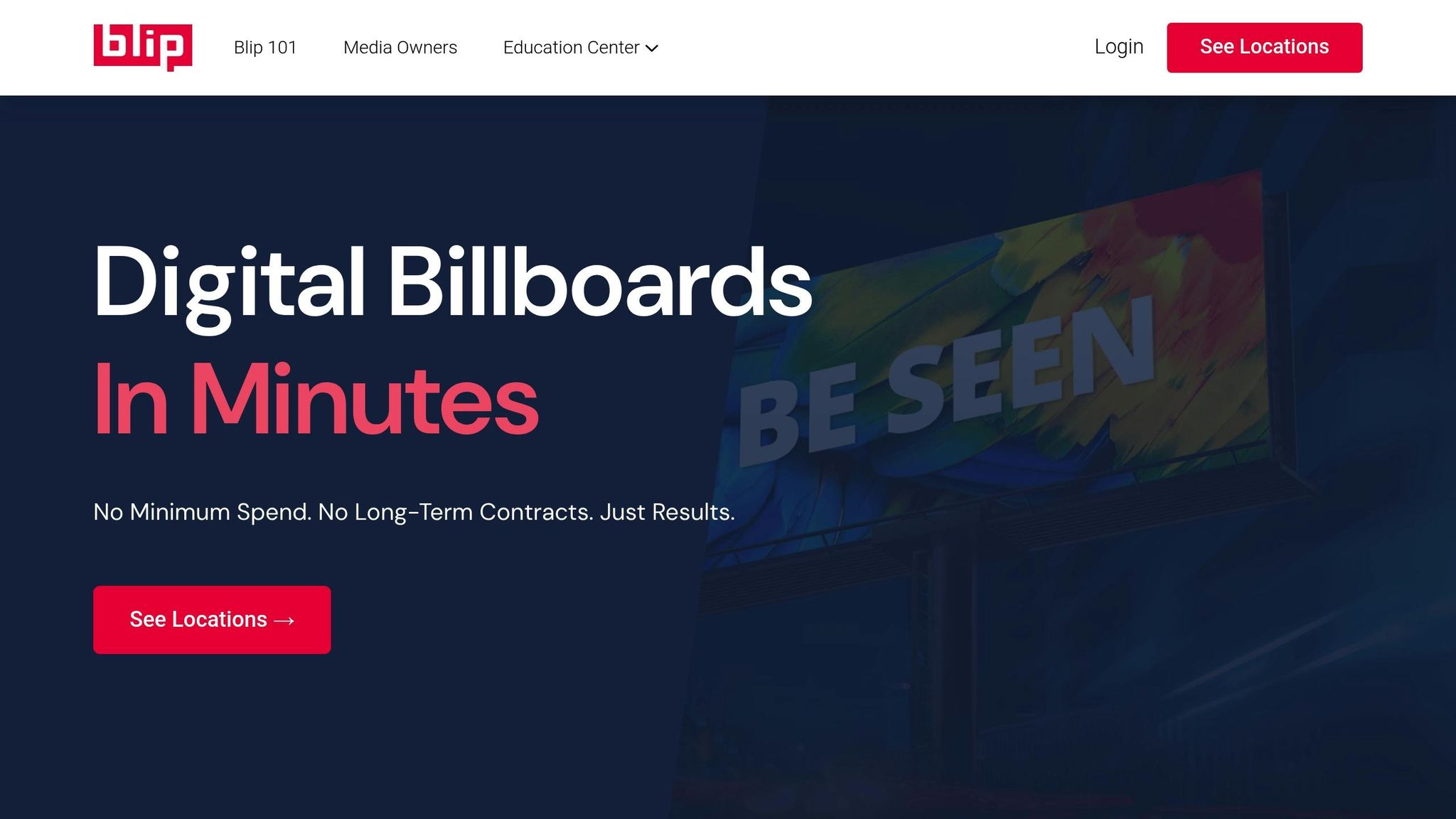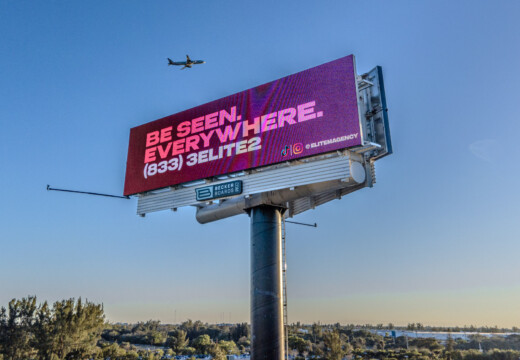Want to make your billboard campaigns more effective and measurable? Transparent monitoring is the key. Here’s what you need to know:
- Real-time Data: Track impressions, audience reach, and engagement instantly.
- Cost Efficiency: Use metrics like CPM (Cost Per Thousand) and pay-per-play to manage budgets effectively.
- Compliance: Ensure your ads meet legal standards with tools for content screening, brightness control, and location verification.
- Performance Insights: Monitor key metrics like daily traffic count, peak hours, and audience demographics to optimize campaigns.
- Stakeholder Communication: Share live performance reports and real-time analytics to build trust.
Quick Tip: Platforms like Blip offer small businesses affordable, data-driven tools to manage billboard ads with budgets starting at $20/day.
With these tools, you can track performance, adjust strategies, and maximize ROI with confidence.
How to Buy Digital Out-of Home-Media with AdQuick – Part and Sum Growth Marketing

Core Performance Metrics
Tracking key performance metrics is essential for advertisers aiming to gauge the success of their billboard campaigns in real time. These metrics serve as a bridge between understanding campaign outcomes and making strategic adjustments, connecting the tools for monitoring with actionable performance insights.
Measuring Audience Reach
The reach of a billboard is primarily measured through impressions, which represent the number of potential viewers exposed to your advertisement. Advanced tracking systems analyze traffic patterns, peak viewing times, and demographic data to generate visibility metrics.
Chris Leslie, Founder of Leslie Lightcraft Co, underscores the unique power of billboard advertising:
“It’s not a social media thing that you see on your phone. It’s not word-of-mouth. It’s big and bold and out there in public. I would say this is the first step of looking big and public.”
Several factors play a role in measuring reach effectively:
| Metric Component | What It Measures | Why It Matters |
|---|---|---|
| Daily Traffic Count | Number of vehicles passing by | Estimates the potential audience size |
| Peak Hours Analysis | High-traffic time periods | Optimizes the timing of ad displays |
| Demographic Data | Characteristics of the audience | Allows for targeted campaign adjustments |
Audience Response Data
Understanding how viewers interact with your billboard is just as important as measuring reach. To evaluate audience response, advertisers can track:
- Dwell time: The average duration viewers spend looking at the ad.
- Brand recall: The percentage of viewers who remember the advertisement’s message.
- Action rates: Measures of viewer engagement, such as visiting a website or making a purchase.
Cost Analysis Methods
Analyzing costs is critical to ensuring your campaign is both effective and efficient. Metrics like CPM, pay-per-play, and ROI tracking provide insights into cost efficiency:
- Cost Per Thousand (CPM): Calculates the expense for every thousand impressions.
- Pay-per-play: Bases costs on the actual time the ad is displayed.
- ROI tracking: Measures conversions to assess the return on investment.
Ray Bowens, Founder of Hashtag-Vape, highlights the affordability of billboard advertising:
“Billboards are one of the most impactful ways to advertise, and with Blip, you spend a fraction of what you would end up paying elsewhere.”
Compliance Standards and Tracking
Keeping up with compliance isn’t just about checking off legal boxes – it’s also a way to improve how your campaigns perform. By aligning with important metrics, effective compliance monitoring ensures billboard advertising stays both lawful and efficient. Today, transparent reporting and systems that confirm adherence to regulations are must-haves in the world of modern billboard advertising.
Billboard Advertising Rules
Thanks to digital tools, managing compliance for advertisers is easier than ever. Here are some key regulatory areas and how they’re monitored:
| Compliance Area | Key Requirements | Monitoring Method |
|---|---|---|
| Content Standards | Material must be age-appropriate and truthful | Content screening |
| Display Duration | Ads must adhere to maximum display times per rotation | Digital timing controls |
| Brightness Levels | Luminance should adjust based on the time of day | Light sensors |
| Location Restrictions | Ads must maintain specific distances from roads or residential areas | Location verification |
This structured approach ensures campaigns meet legal requirements while also fostering confidence among stakeholders. Advertisers are expected to document every step of the compliance process, such as:
- Timestamps for content approvals
- Logs of display schedules
- Records of brightness adjustments
- Verification of location compliance
Content Review Systems
Digital billboard platforms have made it easier to review and approve content to meet compliance standards before a campaign goes live. For example, Blip employs a two-step review process: the first step ensures basic compliance within 90 minutes, while the second step confirms location-specific requirements in 1-3 days. This process creates a thorough audit trail.
sbb-itb-2e2e93f
Communication with Stakeholders
Sharing timely and accurate performance data is key to earning and maintaining stakeholder trust. Thanks to digital platforms, real-time metrics are now easily accessible, offering a clear view into campaign activities and results.
Live Performance Reports
Real-time tracking tools provide instant insights into campaign performance through detailed analytics dashboards. Here’s a breakdown of key report types and their metrics:
| Report Type | Key Metrics | Update Frequency |
|---|---|---|
| Campaign Overview | Impressions, Plays, Budget Spent | Real-time |
| Location Analysis | Traffic Patterns, Peak Hours | Every 10 minutes |
| Financial Reports | Cost per Play, ROI Calculations | Daily |
| Compliance Status | Content Approvals, Display Times | Real-time Updates |
These reports give stakeholders the ability to monitor their campaigns in real time, making it easier to adapt strategies based on up-to-date data. This level of detail strengthens communication and ensures that stakeholders are always informed.
Data Transparency Practices
Clear and open data sharing not only demonstrates the effectiveness of a campaign but also solidifies trust. Here are some key practices to ensure transparency:
- Real-time Analytics Access: Stakeholders can log in anytime to view live dashboards.
- Automated Performance Alerts: Notifications are sent when significant changes occur in key metrics.
- Customizable Reports: Stakeholders can tailor reports to focus on the metrics they care about most.
- Verification Systems: Tools confirm ad plays and ensure compliance with display requirements.
“Blip works for us. It’s a different medium, and it brings a lot of exposure. It sets us apart from the rest of the [competition], and that’s what I like”
Blip‘s Monitoring Features

Managing billboard campaigns effectively calls for tools that offer clear insights and real-time control. Blip’s platform delivers features tailored to give advertisers transparency and flexibility in digital billboard advertising.
Billboard Location Selection
Blip’s interactive marketplace makes it easy to pick the right billboard locations using data-backed insights. Key metrics include:
| Selection Criteria | Metric | Update Frequency |
|---|---|---|
| Audience Reach | Daily Impressions | Real-time |
| Location Performance | Average CPM | Real-time |
| Competitive Pricing | Current Bid Rates | Every 10 minutes |
With these metrics, advertisers can make informed decisions about where to place their ads. Next, we’ll see how Blip’s tracking tools help fine-tune performance in real time.
Performance Tracking Tools
Blip’s platform offers real-time tracking tools that help advertisers respond quickly to campaign data. These tools include:
- Real-time Bidding Updates: Pricing updates every 10 minutes to stay competitive.
- Ad Display Verification: Ensures every ad display is accounted for, boosting transparency.
- Budget Tracking: Live updates on spending to help manage daily budgets effectively.
- Performance Analytics: Offers detailed insights into campaign reach and engagement.
These tools provide advertisers with the information they need to optimize campaigns on the fly, aligning perfectly with strategies for small businesses.
Small Business Tools
Blip is especially user-friendly for small businesses, offering:
- Step-by-step guides for setting up campaigns
- Video tutorials to simplify platform navigation
- Design tips to improve billboard visibility
- A two-step moderation process, with ad approvals in 1-3 days
With a pay-per-play model, campaigns can launch with a budget as low as $20 per day. Advertisers only pay for actual ad displays, making it easy to track costs and measure returns effectively.
Summary
Transparent monitoring is changing the game for outdoor advertising by delivering real-time data and ensuring strict compliance. Advertisers now have access to detailed insights into performance metrics, location analytics, and budget management, giving them unmatched control over their campaigns.
| Aspect | Impact | Business Value |
|---|---|---|
| Real-Time Data | 10-minute bid updates | Smarter ad spending |
| Location Insights | Daily impression tracking | Better ad placement |
| Budget Control | Pay-per-play model | Improved cost management |
| Compliance | 2-step moderation process | Ensured brand safety |
The benefits go far beyond just numbers. Take it from Paul Willey of Mr. Charlie’s Chicken Fingers, who shared:
“Working with Blip has given Mr. Charlie’s the momentum to get our new location on the map while accelerating growth for our original location”.
With these tools, businesses – especially smaller ones – can fine-tune their ad campaigns, stay on budget, and operate with complete transparency. By combining real-time analytics with strong compliance practices, advertisers can not only make smarter, data-driven decisions but also build trust with stakeholders through reliable, measurable outcomes.
FAQs
How does transparent billboard monitoring enhance my advertising campaigns?
Transparent billboard monitoring brings a new level of insight to your advertising efforts by providing access to key metrics, ensuring compliance, and streamlining communication with stakeholders. This visibility allows you to track performance accurately and make informed decisions to refine your strategy.
With real-time performance data at your fingertips, you can tweak campaigns on the fly, ensuring your budget is spent wisely and your message resonates with the right audience. This transparency drives better outcomes and makes your advertising more effective.
What compliance standards should I follow for a successful digital billboard campaign?
When launching a digital billboard campaign, following compliance standards is a must to ensure your ads are both effective and legally sound. Start by checking that your content meets local, state, and federal advertising laws. These regulations often limit specific types of messaging or imagery, so knowing the rules upfront can save you headaches later.
Next, review the billboard operator’s guidelines. These typically cover critical details like file formats, dimensions, and any content restrictions. Sticking to these ensures your ad displays correctly without any delays or rejections.
Lastly, keep an eye on your campaign’s performance. Track metrics such as impressions and CPM to stay transparent with stakeholders and fine-tune your strategy for better results.
How does real-time data tracking improve billboard advertising strategies?
Real-time data tracking gives advertisers the ability to keep a close eye on their billboard campaigns as they unfold. This means they can instantly access performance metrics like impressions and engagement, offering a clear picture of how their ads are doing. With this information at their fingertips, businesses can quickly tweak ad placements or refine messaging to get better results.
Digging into real-time data also helps advertisers spot emerging trends, evaluate the performance of specific locations, and ensure their campaigns stay on track with their objectives. This level of insight doesn’t just improve decision-making – it also helps make the most of every advertising dollar.
Related posts
- Proof of Performance in Billboard Ads
- How Cross-Device Segmentation Boosts Billboard Ads
- How Data Improves Billboard Audience Targeting
- How to Analyze Billboard Engagement Metrics
Transparent billboard monitoring brings a new level of insight to your advertising efforts by providing access to key metrics, ensuring compliance, and streamlining communication with stakeholders. This visibility allows you to track performance accurately and make informed decisions to refine your strategy.
With real-time performance data at your fingertips, you can tweak campaigns on the fly, ensuring your budget is spent wisely and your message resonates with the right audience. This transparency drives better outcomes and makes your advertising more effective.
"}},{"@type":"Question","name":"What compliance standards should I follow for a successful digital billboard campaign?","acceptedAnswer":{"@type":"Answer","text":"
When launching a digital billboard campaign, following compliance standards is a must to ensure your ads are both effective and legally sound. Start by checking that your content meets local, state, and federal advertising laws. These regulations often limit specific types of messaging or imagery, so knowing the rules upfront can save you headaches later.
Next, review the billboard operator's guidelines. These typically cover critical details like file formats, dimensions, and any content restrictions. Sticking to these ensures your ad displays correctly without any delays or rejections.
Lastly, keep an eye on your campaign's performance. Track metrics such as impressions and CPM to stay transparent with stakeholders and fine-tune your strategy for better results.
"}},{"@type":"Question","name":"How does real-time data tracking improve billboard advertising strategies?","acceptedAnswer":{"@type":"Answer","text":"
Real-time data tracking gives advertisers the ability to keep a close eye on their billboard campaigns as they unfold. This means they can instantly access performance metrics like impressions and engagement, offering a clear picture of how their ads are doing. With this information at their fingertips, businesses can quickly tweak ad placements or refine messaging to get better results.
Digging into real-time data also helps advertisers spot emerging trends, evaluate the performance of specific locations, and ensure their campaigns stay on track with their objectives. This level of insight doesn’t just improve decision-making - it also helps make the most of every advertising dollar.
"}}]}


